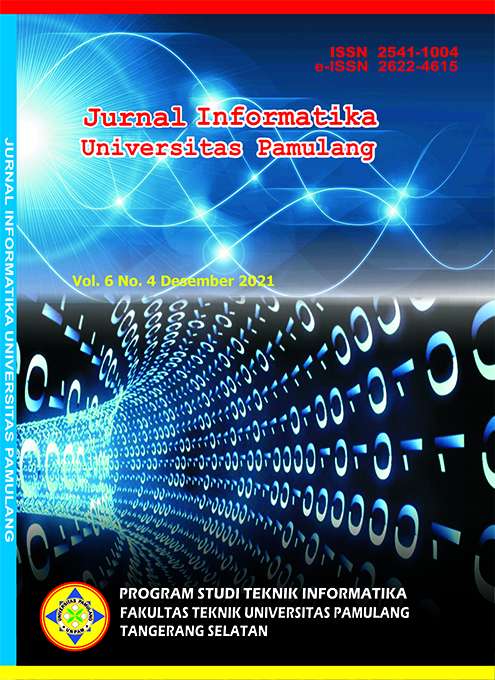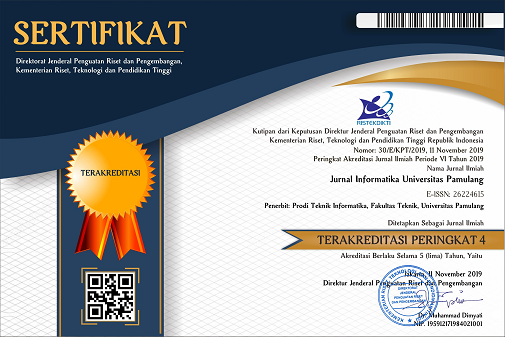TIA-942 Approach dengan Computational Fluid Dynamic untuk Data Center
DOI:
https://doi.org/10.32493/informatika.v6i4.12874Keywords:
TIA-942, Computational Fluid Dynamic, DC, service providerAbstract
Data Center (DC) is currently one of the most popular Information and Communication Technologies (ICT) along with the increasing digitization of business processes. The concept of centralization provides convenience for the improvement, development and efficiency of energy resources. DC networks support cloud-inspired environments that require stability and agility, thereby extending the functionality of DC networks into a public cloud provider infrastructure to better manage hybrid cloud networks. The TIA-942 standard allows DC designs to be considered early in the building development process and contributes to architectural considerations, by providing multidisciplinary design and construction information. It is used for a comprehensive understanding of DC design including facility planning, cabling systems, and network design. Good planning during building construction or renovation is significantly less expensive and less intrusive than after the facility is operational. The DC design using the TIA-942 standard was tested through Computational Fluid Dynamic simulation to produce a better analysis. All of these analyzes are to avoid misplacing or positioning cooling devices or racks in the DC, as well as assisting in the selection of efficient cooling system technology. So that the DC design can function as an operation center and service provider, as well as increase efficiency and energy resources for all SKPD in XYZ Province.
References
Caesar, Ibnu., dkk. (2016). Analisis dan Perancangan Power Management Data Center Berdasarkan Tiering Level di Pemerintahan Kabupaten Bandung Menggunakan Standar TIA-942 dengan Metode PPDIOO Life-Cycle Approach, Jurnal Rekayasa Sistem & Industri, Vol 3, No.4.
Dewandaru, D. S., & Bachtiar, A. (2014). Perancangan Desain Ruang Data Center Menggunakan Standar TIA-942 (Studi Kasus : PUSLITBANG Jalan dan Jembatan). Seminar Nasional Sistem Informasi Indonesia, 942(September), 1–8.
Dunlap, K., & Rasmussen, N. (2006). The Advantages of Row and Rak- oriented Cooling Architectures for Data Centers. APC White Paper, 1–19. http://www.apcmedia.com/salestools/VAVR-6J5VYJ_R1_EN.pdf
Elfanuary, Febryan., dkk. (2017). Best Practice Design Building Gacilities and Data Center Layaout Based on Tiering Level of TIA-942 Standard using PPDIOO Method in Pemerintah Kabupaten Bandung, Jurnal Rekayasa Sistem & Industri, Vol 4, No.2.
F.F. Asali dan I. Afrianto (2017). Rekomendasi Data Center Menggunakan Pendekatan Standarisasi TIA-942 di Puslitbang XYZ. Jurnal CoreIT, Vol 3, No.1.
Gartner. (2020). Magic Quadrant for Data Center and Cloud Networking.
HPL Raised Floor. (n.d.). Retrieved August 9, 2021, from https://www.powerfloor.com.my/hpl-raised-floor/
Rasmussen, N. (2014). Raised Floors vs Hard Floors for Data Center Applications Executive summary Raised Floors vs Hard Floors for Data Center Applications.http://www.apc.com/salestools/SADE-5TNQYN/SADE-5TNQYN_R3_EN.pdf
Santos, F. et al. (2020). New Data Center Performance Index: Perfect Designs Data Center-PDD, Climate, Oct.
Sidabutar, Jeckson. (2020). Desain Jaringan Komputer Terintegrasi Menggunakan Arsitektur Campus LAN, Jurnal Jaring SainTek, Vol 2, No.1.
TIA-942, (2005). Telecommunications Infrastructure Standard for Data Centers, April.
Tn, W. K. (2016). Understanding Raised Floor Systems for the Specifier The Access Flooring Company.
Wahdini, Fatimah., dkk. (2020). Network Traffic Data Center Based on TIA-942 Standard: A Case Study in Bogor Government Office, Journal of Advances in Computer Networks, Vol 8, No. 1.
Wiyata Putra, IDP dan Wahyu Aristana, Made. (2019). Perancangan Desain Ruangan Data Center Menggunakan Standar TIA-942, Jurnal Resistor. Vol 2, No.1.
Downloads
Published
Issue
Section
License
Authors who publish with this journal agree to the following terms:
- Authors retain copyright and grant the journal right of first publication with the work simultaneously licensed under a Creative Commons Attribution-NonCommercial 4.0 International (CC BY-NC 4.0) that allows others to share the work with an acknowledgement of the work's authorship and initial publication in this journal.
- Authors are able to enter into separate, additional contractual arrangements for the non-exclusive distribution of the journal's published version of the work (e.g., post it to an institutional repository or publish it in a book), with an acknowledgement of its initial publication in this journal.
- Authors are permitted and encouraged to post their work online (e.g., in institutional repositories or on their website) prior to and during the submission process, as it can lead to productive exchanges, as well as earlier and greater citation of published work (See The Effect of Open Access).
Jurnal Informatika Universitas Pamulang have CC-BY-NC or an equivalent license as the optimal license for the publication, distribution, use, and reuse of scholarly work.
In developing strategy and setting priorities, Jurnal Informatika Universitas Pamulang recognize that free access is better than priced access, libre access is better than free access, and libre under CC-BY-NC or the equivalent is better than libre under more restrictive open licenses. We should achieve what we can when we can. We should not delay achieving free in order to achieve libre, and we should not stop with free when we can achieve libre.
Jurnal Informatika Universitas Pamulang is licensed under a Creative Commons Attribution-NonCommercial 4.0 International (CC BY-NC 4.0)
YOU ARE FREE TO:
- Share : copy and redistribute the material in any medium or format
- Adapt : remix, transform, and build upon the material for any purpose, even commercially.
- The licensor cannot revoke these freedoms as long as you follow the license terms





